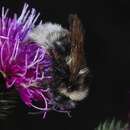Biology
provided by Arkive
The name cuckoo bumblebee refers to the fact that these bees are brood parasites in the nests of other bumblebees (3). Bombus terrestris (the great earth bumblebee) is the only known host of Bombus vestalis, and the cuckoo's distribution reflects the predominantly southern distribution of its host in Britain (4) and, presumably also throughout its palaearctic range (2).
Cuckoo bumblebees do not have a 'worker' caste, like other bumblebees. Instead all the hard work of brood rearing and foraging is carried out by the host colony. Mated female cuckoo bees hibernate through the winter, and emerge in the spring later than their hosts. They feed on flowers for a while before searching out a suitable host nest. They depend on finding, by sight or scent or a combination of the two, a host nest, which needs to be sufficiently advanced to have a worker population large enough to rear the cuckoo bee's offspring (2). The thick, heavily armoured cuticle of the female cuckoo bee helps to protect her from aggressive encounters with the hosts, who attempt to defend their nest (4). The cuckoo bee may put up with unfriendly attention from workers, and wait for them to calm down, before finding a quiet part of the nest to hide in. Alternatively, there may be a battle in which the cuckoo bee is either successful in killing numbers of workers, and is finally accepted, or is herself killed (9). After a time of lying low within the host colony, perhaps to take on the scent of the hosts, the cuckoo bumblebee female sets about laying eggs (4). At some stage, she will fight the host queen, who is usually killed (2). She kills host eggs and larvae and uses the wax from host cells to make her own. After the cuckoo bumblebee larvae have developed into pupae and then adults, they leave the host nest and feed on flowers. After mating occurs the females go into hibernation and the males die before the onset of winter (4).
Conservation
provided by Arkive
The Bumblebee Working Group has produced a leaflet called Help save the bumblebee…get more buzz from your garden in order to advise householders and farmers on ways to help the bumblebees (6)
Description
provided by Arkive
Until recently, cuckoo bumblebees were once considered to belong to a separate genus (Psithyrus) in recognition of their distinctive appearance and their behaviour as parasites in the colonies of other bumblebees. Lately, experts have, by and large, agreed that all bumblebees belong to a single genus, Bombus, with Psithyrus as a subgenus (3). Cuckoo bees are similar in appearance to bumblebees, but they have a softer 'buzz', indeed Psithyrus means 'murmuring' as opposed to 'Bombus', which means 'booming'. Other differences include the lack of pollen baskets on the legs and a sparser coat of hairs, through which the shiny black cuticle can easily be seen (4).
Habitat
provided by Arkive
Found in a variety of habitats including gardens and grasslands. Host nests are typically made in old vole or mouse burrows in rough grassland, often beside hedges (6).
Range
provided by Arkive
Found in the Palaearctic region (5).
Status
provided by Arkive
Not currently threatened (2).
Threats
provided by Arkive
Although this species is not threatened at present, there has been a dramatic country-wide decline in bumblebees, largely as a result of the loss of large areas of suitable farmland habitats (6). As this species depends on the presence of host colonies, it is affected by declines in the host population.

